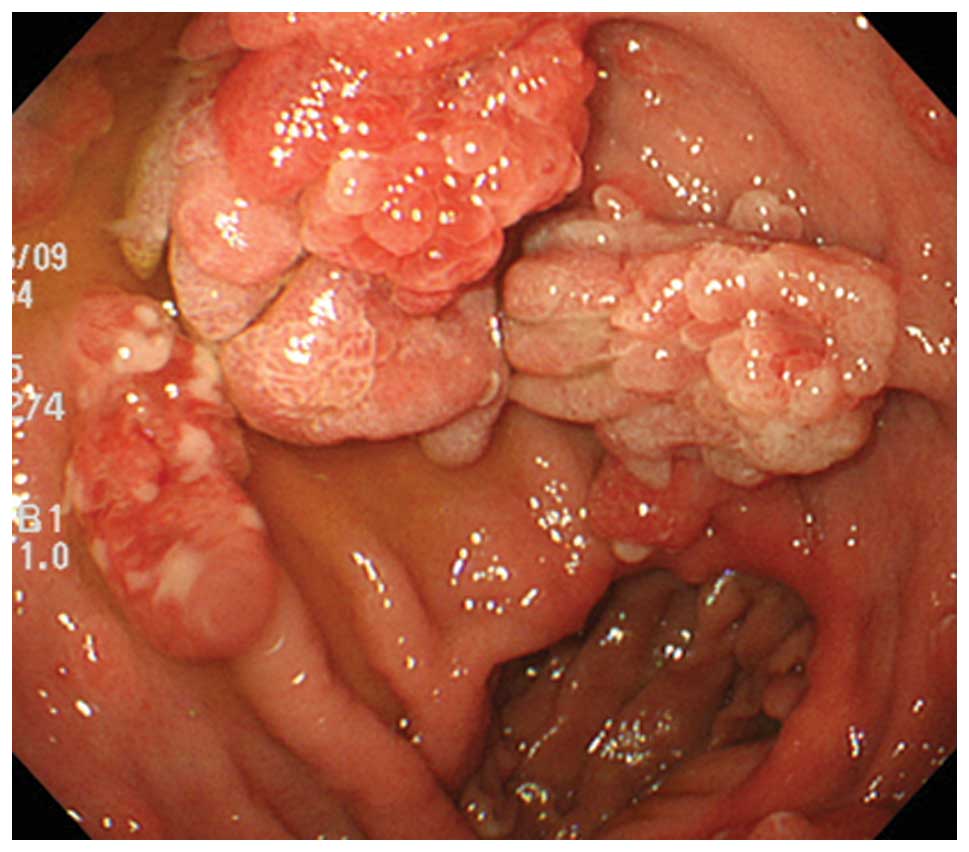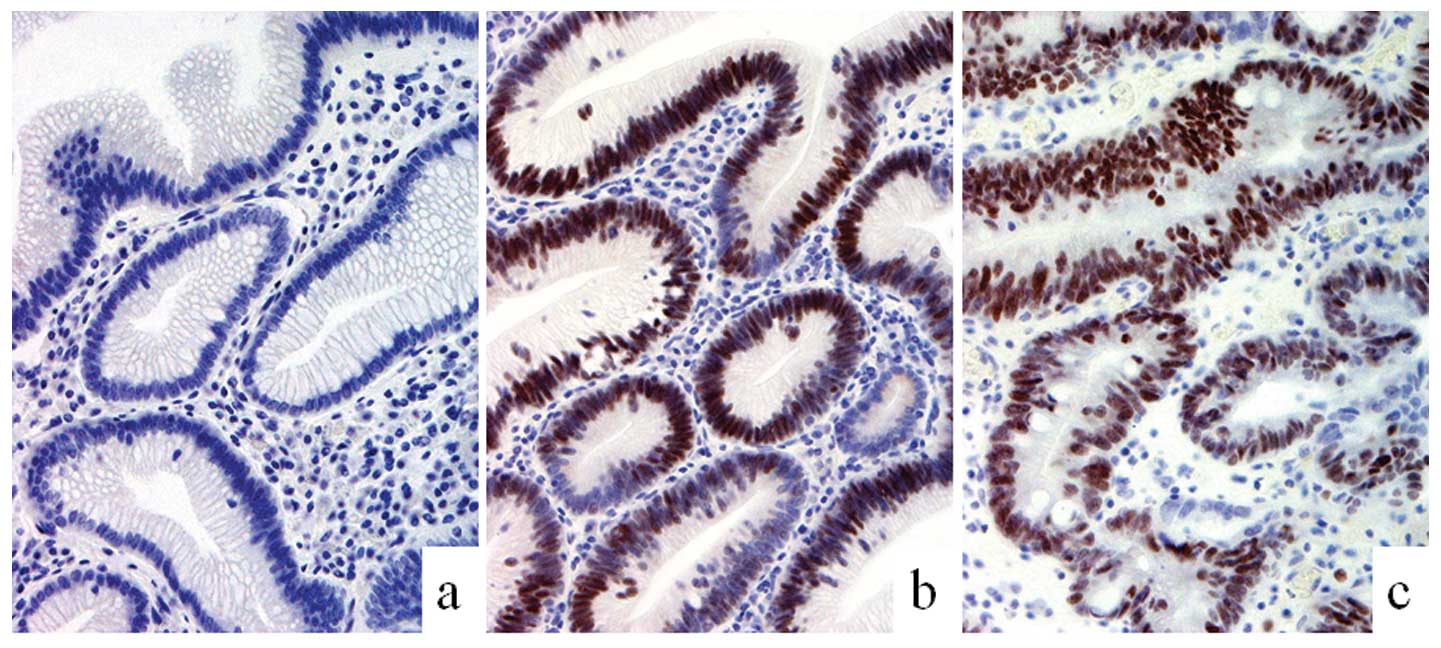|
1
|
Ueno K, Oshiba S, Yamagata S, et al:
Histo-clinical classification and follow-up study of gastric polyp.
Tohoku J Exp Med. 118(Suppl): S23–S38. 1976. View Article : Google Scholar
|
|
2
|
Kozuka S, Masamoto K, Suzuki S, et al:
Histogenetic types and size of polypoid lesions in the stomach,
with special reference to cancerous change. Gann. 68:267–274.
1977.
|
|
3
|
Laxén F, Sipponen P, Ihamäki T, et al:
Gastric polyps; their morphological and endoscopical
characteristics and relation to gastric carcinoma. Acta Pathol
Microbiol Immunol Scand A. 90:221–228. 1982.PubMed/NCBI
|
|
4
|
Hattori T: Morphological range of
hyperplastic polyps and carcinomas arising in hyperplastic polyps
of the stomach. J Clin Pathol. 38:622–630. 1985. View Article : Google Scholar : PubMed/NCBI
|
|
5
|
Daibo M, Itabashi M and Hirota T:
Malignant transformation of gastric hyperplastic polyps. Am J
Gastroenterol. 82:1016–1025. 1987.
|
|
6
|
Zea-Iriarte WL, Sekine I, Itsuno M, et al:
Carcinoma in gastric hyperplastic polyps. A phenotypic study. Dig
Dis Sci. 41:377–386. 1996. View Article : Google Scholar : PubMed/NCBI
|
|
7
|
Orlowska J and Kupryjanczyk J: Malignant
transformation of gastric hyperplastic polyps. Am J Clin Pathol.
117:165–166. 2002.PubMed/NCBI
|
|
8
|
Ajiki T, Nakamura T, Suehiro I, et al:
Increased immunohistochemical labeling indices as indicators of
malignant transformation of a gastric hyperplastic polyp. Am J
Gastroenterol. 97:211–212. 2002. View Article : Google Scholar
|
|
9
|
Bosseckert H, Kratzsch KH, Machnik G, et
al: Hyperplasiogenic polyps and stomach carcinoma risk-experiences
following 1074 polypectomies and follow-up studies. Schweiz Rundsch
Med Prax. 79:537–539. 1990.(In German).
|
|
10
|
Gschwantler M, Pulgram T, Feichtenschlager
T, et al: Gastric carcinoma arising from a hyperplasiogenic polyp
with a diameter of less than 2 centimeters. Z Gastroenterol.
33:610–612. 1995.
|
|
11
|
Joffe N and Antonioli DA: Atypical
appearances of benign hyperplastic gastric polyps. AJR.
131:147–152. 1978. View Article : Google Scholar : PubMed/NCBI
|
|
12
|
Orlowska J, Jarosz D, Pachlewski J and
Butruk E: Malignant transformation of benign epithelial gastric
polyps. Am J Gastroenterol. 90:2152–2159. 1995.PubMed/NCBI
|
|
13
|
Remmele W and Kolb EF: Malignant
transformation of hyperplasiogenic polyps of the stomach - case
report. Endoscopy. 10:63–65. 1978. View Article : Google Scholar : PubMed/NCBI
|
|
14
|
Yao T, Kajiwara M, Kuroiwa S, et al:
Malignant transformation of gastric hyperplastic polyps: alteration
of phenotypes, proliferative activity, and p53 expression. Hum
Pathol. 33:1016–1022. 2002. View Article : Google Scholar : PubMed/NCBI
|
|
15
|
Tatematsu M, Ichinose M, Miki K, et al:
Gastric and intestinal phenotypic expression of human stomach
cancers as revealed by pepsinogen immunohistochemistry and mucin
histochemistry. Acta Pathol Jpn. 40:494–504. 1990.
|
|
16
|
Chang SK, Dohrman AF, Basbaum CB, et al:
Localization of mucin (MUC2 and MUC3) messenger RNA and peptide
expression in human normal intestine and colon cancer.
Gastroenterology. 107:28–36. 1994.PubMed/NCBI
|
|
17
|
Morohara K, Tajima Y, Nakao K, et al:
Gastric and intestinal phenotypic cell marker expressions in
gastric differentiated-type carcinomas: association with E-cadherin
expression and chromosomal changes. J Cancer Res Clin Oncol.
132:363–375. 2006. View Article : Google Scholar
|
|
18
|
Trejdosiewicz LK, Malizia G, Oakes J, et
al: Expression of the common acute lymphoblastic leukaemia antigen
(CALLA gp100) in the brush border of normal jejunum and jejunum of
patients with coeliac disease. J Clin Pathol. 38:1002–1006. 1985.
View Article : Google Scholar
|
|
19
|
Weiss AA, Babyatsky MW, Ogata S, et al:
Expression of MUC2 and MUC3 mRNA in human normal, malignant, and
inflammatory intestinal tissues. J Histochem Cytochem.
44:1161–1166. 1996. View Article : Google Scholar : PubMed/NCBI
|
|
20
|
Tsukita S, Furuse M and Itoh M:
Multifunctional strands in tight junctions. Nat Rev Mol Cell Biol.
2:285–293. 2001. View
Article : Google Scholar : PubMed/NCBI
|
|
21
|
Matsuda Y, Semba S, Ueda J, et al: Gastric
and intestinal claudin expression at the invasive front of gastric
carcinoma. Cancer Sci. 98:1014–1019. 2007. View Article : Google Scholar : PubMed/NCBI
|
|
22
|
Resnick MB, Gavilanez M, Newton E, et al:
Claudin expression in gastric adenocarcinomas: a tissue microarray
study with prognostic correlation. Hum Pathol. 36:886–892. 2005.
View Article : Google Scholar
|
|
23
|
Cunningham SC, Kamangar F, Kim MP, et al:
Claudin-4, mitogen-activated protein kinase kinase 4, and stratifin
are markers of gastric adenocarcinoma precursor lesions. Cancer
Epidemiol Biomarkers Prev. 15:281–287. 2006. View Article : Google Scholar
|
|
24
|
Fedwick JP, Lapointe TK, Meddings JB, et
al: Helicobacter pylori activates myosin light-chain kinase to
disrupt claudin-4 and claudin-5 and increase epithelial
permeability. Infect Immun. 73:7844–7852. 2005. View Article : Google Scholar
|
|
25
|
Satake S, Semba S, Matsuda Y, et al: Cdx2
transcription factor regulates claudin-3 and claudin-4 expression
during intestinal differentiation of gastric carcinoma. Pathol Int.
58:156–163. 2008. View Article : Google Scholar : PubMed/NCBI
|
|
26
|
Shinozaki A, Ushiku T, Morikawa T, et al:
Epstein-Barr virus-associated gastric carcinoma: a distinct
carcinoma of gastric phenotype by claudin expression profiling. J
Histochem Cytochem. 57:775–785. 2009. View Article : Google Scholar
|
|
27
|
Sentani K, Oue N, Tashiro T, et al:
Immunohistochemical staining of Reg IV and claudin-18 is useful in
the diagnosis of gastrointestinal signet ring cell carcinoma. Am J
Surg Pathol. 32:1182–1189. 2008. View Article : Google Scholar : PubMed/NCBI
|
|
28
|
Schlemper RJ, Riddell RH, Kato Y, et al:
The Vienna classification of gastrointestinal epithelial neoplasia.
Gut. 47:251–255. 2000. View Article : Google Scholar : PubMed/NCBI
|
|
29
|
Hizawa K, Fuchigami T, Iida M, et al:
Possible neoplastic transformation within gastric hyperplastic
polyp. Application of endoscopic polypectomy. Surg Endosc.
9:714–718. 1995.
|
|
30
|
Kushima R and Hattori T: Histogenesis and
characteristics of gastric-type adenocarcinomas in the stomach. J
Cancer Res Clin Oncol. 120:103–111. 1993. View Article : Google Scholar : PubMed/NCBI
|
|
31
|
Park do Y, Srivastava A, Kim GH, et al:
CDX2 expression in the intestinal-type gastric epithelial
neoplasia: frequency and significance. Mod Pathol. 23:54–61.
2010.PubMed/NCBI
|
|
32
|
Lauwers GY, Wahl SJ, Melamed J and
Rojas-Corona RR: p53 expression in precancerous gastric lesions: an
immunohistochemical study of PAb 1801 monoclonal antibody on
adenomatous and hyperplastic gastric polyps. Am J Gastroenterol.
88:1916–1919. 1993.
|















